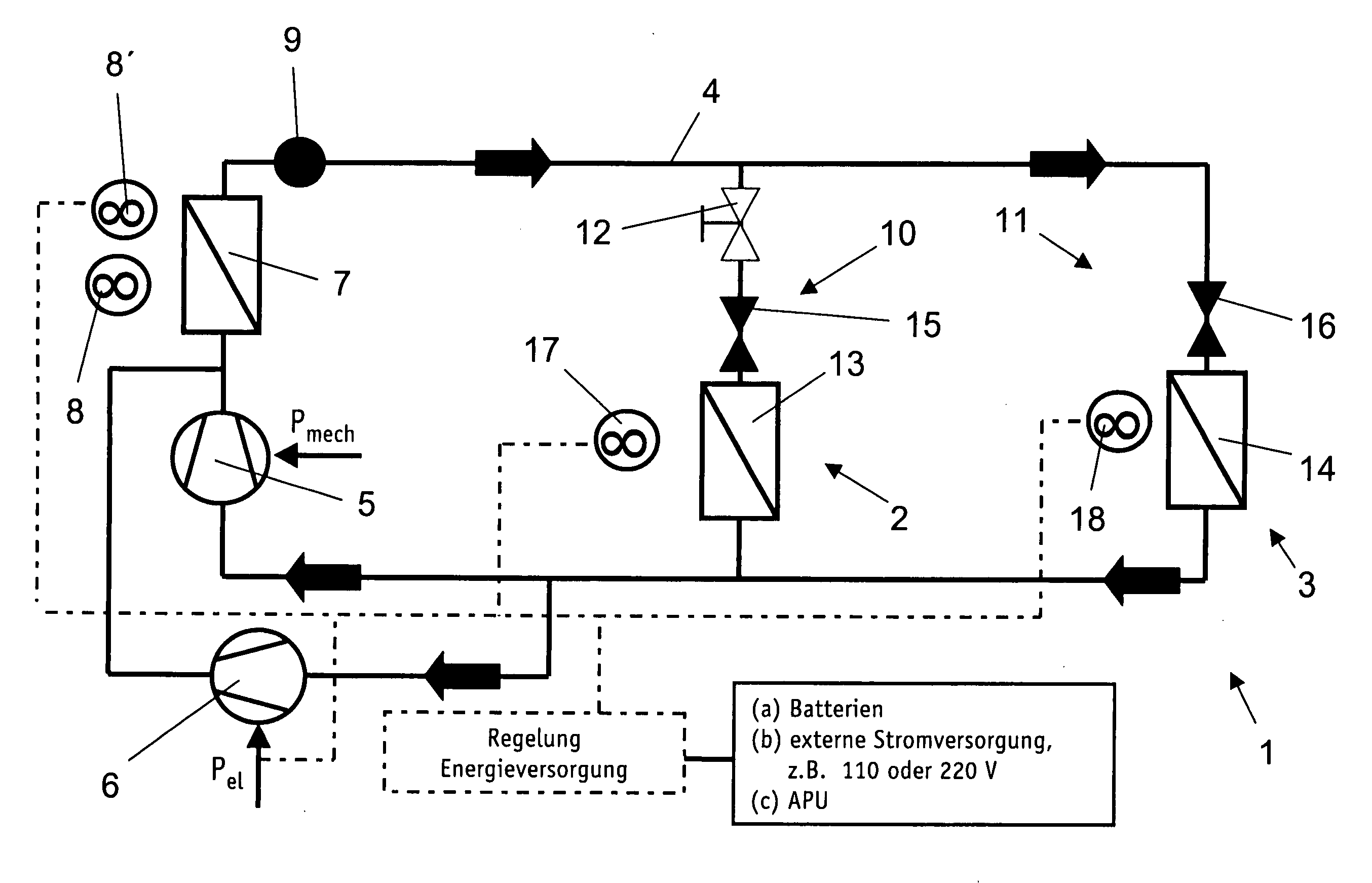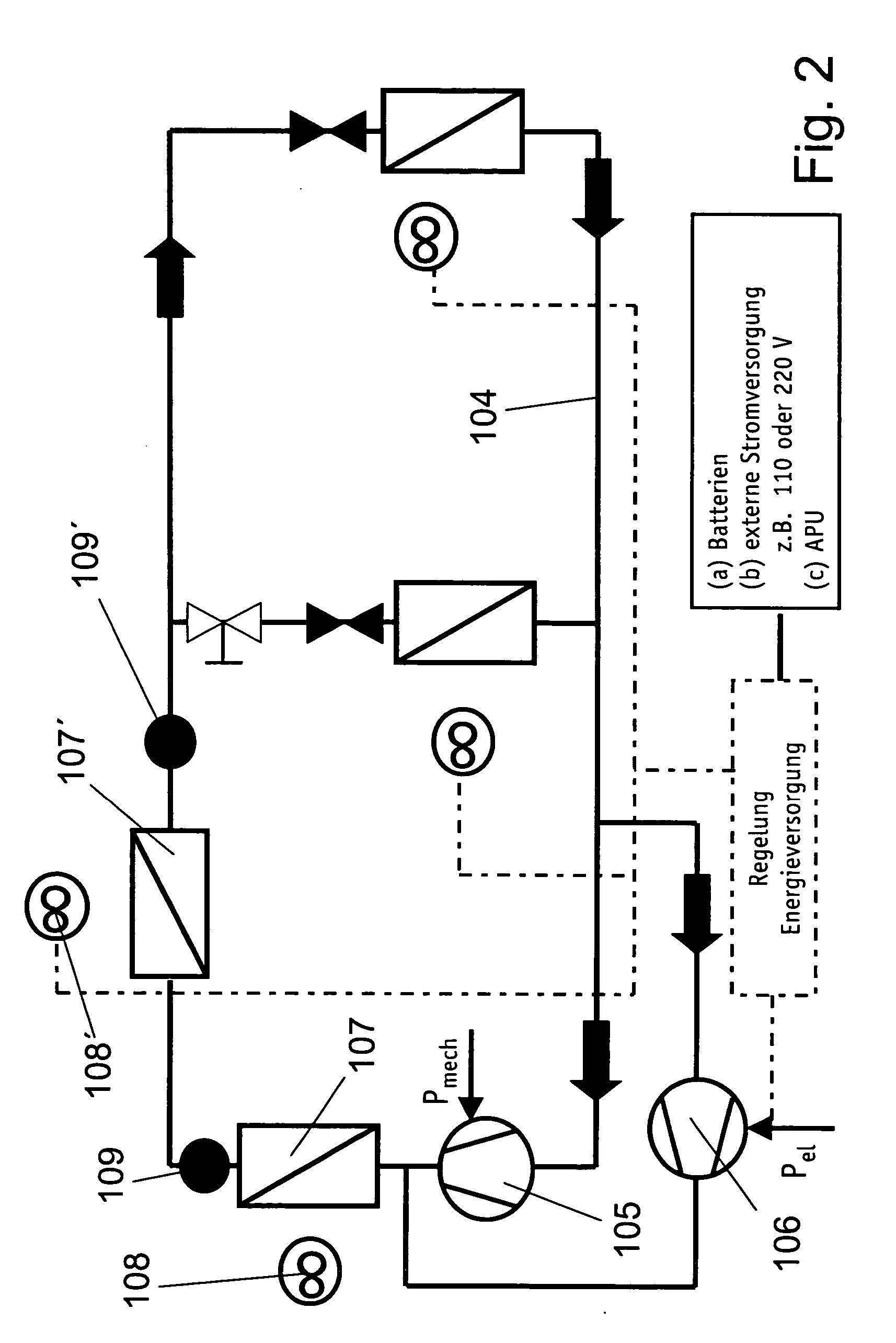Stationary vehicle air conditioning system and method
a technology for stationary vehicles and air conditioning systems, which is applied in the direction of indirect heat exchangers, compression machines with several condensers, light and heating apparatus, etc. it can solve the problems of cooling systems that typically require undesirable charging time and components that do not permit optimal operation of cooling systems, and achieve optimal utilization, simple regulation, and available energy
- Summary
- Abstract
- Description
- Claims
- Application Information
AI Technical Summary
Benefits of technology
Problems solved by technology
Method used
Image
Examples
first embodiment
[0032] In the invention, as illustrated in FIG. 1, two compressors 5 and 6 are arranged in parallel branches of refrigerant circuit 4. In order to prevent backflow when second compressor 6 is not running, a check valve (not shown) is arranged in the corresponding branch of refrigerant circuit 4, downstream of second compressor 6 in the direction of refrigerant flow. A matching check valve can also be provided in the other branch downstream of first compressor 5.
[0033] The flow of refrigerant through circuit 4 in “normal” operation, i.e., with the vehicle's engine running, will be described first. Compressor 5 drives refrigerant, which is hot as a result of compression, through a condenser 7 that is cooled by air via a first vehicle-engine driven fan 8. Condenser 7 may be further cooled by wind or by an air stream generated through the motion of the vehicle. Downstream of condenser 7, a receiver 9 collects and temporarily stores excess liquid refrigerant.
[0034] As illustrated in FIG...
third embodiment
[0040] the invention, which is illustrated in FIG. 3, overlaps with the previously described embodiments as will be appreciated by persons of skill in the art. Unlike the embodiment of FIG. 2, however, a bypass branch is provided downstream of a first condenser and receiver 209. In a normal operating mode, the valve upstream of second condenser 207′ is closed and the valve in the bypass is open. The second condenser 207′ is thus effectively removed from the refrigerant circuit due the diversion of refrigerant. When switched to a second operating mode, such as when the vehicle engine stops running, the valve upstream of second condenser 207′ is opened and the other valve is closed, thereby closing the bypass and forcing refrigerant to flow through second condenser 207′ and second receiver 209′. In this latter mode of operation, fan 208 is inactive, but second fan 208′ supplies an air stream to condenser 207′ for heat transfer purposes.
[0041]FIG. 4 illustrates a fourth embodiment of t...
seventh embodiment
[0042] In the invention, as illustrated in FIG. 7, the refrigerant circuit 604 can be selectively divided by means of valves 620, 621 into a refrigerant circuit 604a for front air conditioner 602 and a refrigerant circuit 604b for rear air conditioner 603. An electrical source provides power to electrically drivable compressors 606a and 606b. Condensers 607a, 607b are respectively arranged downstream of each compressor. The separation of the larger circuit 604 into two sub-circuits by means of the valves 620, 621 allows optimized cooling to fit the need, particularly in stationary operation.
[0043] In a first and normal operating mode, valves 620, 621 are opened, and compressor 606a circulates refrigerant through circuit 604. Appropriate sensors, switches and control logic (not shown) detect and select the position of valves 620, 621, as well as the operation of compressor 606b, which remains inactive in this mode of operation. Compressor 606a drives refrigerant through condenser 607...
PUM
 Login to View More
Login to View More Abstract
Description
Claims
Application Information
 Login to View More
Login to View More - R&D
- Intellectual Property
- Life Sciences
- Materials
- Tech Scout
- Unparalleled Data Quality
- Higher Quality Content
- 60% Fewer Hallucinations
Browse by: Latest US Patents, China's latest patents, Technical Efficacy Thesaurus, Application Domain, Technology Topic, Popular Technical Reports.
© 2025 PatSnap. All rights reserved.Legal|Privacy policy|Modern Slavery Act Transparency Statement|Sitemap|About US| Contact US: help@patsnap.com



